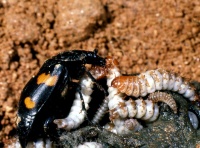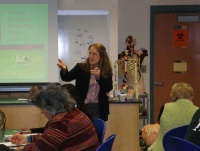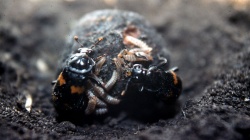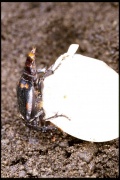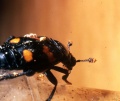Difference between revisions of "Stephen Trumbo"
| Line 53: | Line 53: | ||
'''Research'''<br> | '''Research'''<br> | ||
| − | Trumbo, S.T. 2012. Contest behavior and other reproductive efforts in aging breeders: a test of residual reproductive value and state-dependent models. Behavioral Ecology and Sociobiology 66: 1511-1518. DOI: 10.1007/s00265-012-1406-4. | + | Trumbo, S.T. 2012. Contest behavior and other reproductive efforts in aging breeders: a test of residual reproductive value and state-dependent models. Behavioral Ecology and Sociobiology 66: 1511-1518. DOI: 10.1007/s00265-012-1406-4. {{pdf|http://hydrodictyon.eeb.uconn.edu/people/Stephen Trumbo/2012-BES-contest.pdf}} |
Trumbo, S.T. 2009. Age-related reproductive performance in the parental burying beetle, ''Nicrophorus orbicollis''. ''Behavioral Ecology'' 20: 951-956. {{pdf|http://hydrodictyon.eeb.uconn.edu/people/trumbo/2009-BE-age.pdf}} | Trumbo, S.T. 2009. Age-related reproductive performance in the parental burying beetle, ''Nicrophorus orbicollis''. ''Behavioral Ecology'' 20: 951-956. {{pdf|http://hydrodictyon.eeb.uconn.edu/people/trumbo/2009-BE-age.pdf}} | ||
Revision as of 17:17, 6 May 2013
Professor (Ph.D., University of North Carolina, Chapel Hill) trumbo@uconn.edu
Contents
Research Projects
Aging
There have been three primary approaches to the study of aging: evolutionary ecology asks why and when we senesce, molecular biology examines the cellular mechanisms of aging, and behavioral ecology addresses how aging affects reproductive effort. We are examining how reproductive effort and performance vary with age, and whether all components of reproduction are similarly altered. Burying beetles provide a useful model because alternative hypotheses for improvements with age (more experience and the loss of less fit individuals from the older cohort) can be controlled easily in the laboratory.
Juvenile hormone
Juvenile hormone (JH) has numerous physiological and behavioral effects in larval and adult insects. In burying beetles, high levels of JH are correlated with periods of intense parental activity. Manipulation of JH levels, however, seems to have minimal effects on care-giving. In collaboration with Dr. Claudia Rauter (University of Nebraska-Omaha), we are broadening the study of JH to include JH effects on metabolic rates, which are known to vary predictably during the parental cycle.
Microbiology of carcass preparation
Burying beetles are thought to control the decomposition of a small carcass by burying, removing hair or feathers, rounding, and applying antimicrobial anal and oral secretions. These secretions, however, are loaded with their own particular microbial community that will proliferate once on the carcass. Working with Dr. Paula Philbrick (UConn-Waterbury) we are investigating whether burying beetles are manipulating the microbial community to their advantage rather than simply disinfecting the carcass.
Parental care
Biparental care is increasingly viewed as a conflict. On the other hand, there is much attention to how cooperation can evolve among individuals in groups, particularly in the social insects. I feel that it will be instructive to view these two situations from a common perspective: biparental care as a potentially cooperative effort of two unrelated individuals in which both individuals benefit from greater group productivity (more offspring) while attempting to minimize costs by manipulating the partner to provide more care. As in social insects, specialization may promote stable groups because a deserted individual will not be able to perform nonspecialist tasks as efficiently as its partner.
Nicrophorus pustulatus as a parasitoid of snakes
N. pustulatus has been an enigmatic species of burying beetle because it was never found breeding on a small carcass. Drs. Gabriel Blouin-Demers and Patrick Weatherhead (University of Illinois-Urbana) found N. pustulatus adults and larvae in the nests of the black rat snake (Elaphe obsoleta). Working in our lab, Garrison Smith (M.S., University of Arizona) determined that this species is well adapted to exploiting reptile eggs using many of the same behaviors that congeners use when exploiting carcasses (see September, 2009 issue of Natural History). The closest phylogenetic relatives of N. pustulatus (determined by Derek Sikes, University of Alaska-Fairbanks Museum) have not been studied so it is unknown whether additional nicrophorine species act as parasitoids of reptiles.
Publications
Reviews
Trumbo, S.T. (in press). Maternal care, iteroparity and the evolution of social behavior: a critique of the semelparity hypothesis. "Evolutionary Biology" DOI: 10.1007/s11692-013-9237-4.
Trumbo, S.T. 2012. Patterns of parental care in invertebrates. In: The Evolution of Parental Care (eds., Royle, N.J., Smiseth, P.T., Kölliker, M), pp.81-100. Oxford University Press, Oxford.
Trumbo, S.T. 2007. Can the challenge hypothesis be applied to insects? Hormones and Behavior 51: 281-285. ![]()
Trumbo, S.T. 2002. Hormonal regulation of parental behavior in insects. In: Hormones, Brain and Behavior, Volume 3 (eds., Pfaff, D.W., Arnold, A.P., Etgen, A.M., Fahrbach, S.E., Moss, R.L., Rubin, R.R.), pp. 115-139. Academic Press, New York.
![]()
Trumbo, S.T. 1999. Using integrative biology to explore constraints on evolution. Trends in Ecology & Evolution 14: 5-6. ![]()
Trumbo, S.T. 1997. Juvenile hormone-mediated reproduction in burying beetles: from behavior to physiology. Archives of Insect Biochemistry and Physiology 35: 479-490. ![]()
Trumbo, S.T. 1996. Parental care in invertebrates. Advances in the Study of Behavior 25: 3-51. ![]()
Research
Trumbo, S.T. 2012. Contest behavior and other reproductive efforts in aging breeders: a test of residual reproductive value and state-dependent models. Behavioral Ecology and Sociobiology 66: 1511-1518. DOI: 10.1007/s00265-012-1406-4. ![]()
Trumbo, S.T. 2009. Age-related reproductive performance in the parental burying beetle, Nicrophorus orbicollis. Behavioral Ecology 20: 951-956. ![]()
Trumbo, S.T. 2009. Naturalist at Large: From Gravedigger to Assassin. Natural History September 24-25. ![]()
Sikes, D.S., Vamosi, S.M., Trumbo, S.T., Ricketts, M. and Venables, C. 2008. Molecular systematics and biogeography of Nicrophorus in part - the investigator species group (Coleoptera: Silphidae) using mixture model MCMC. Molecular Phylogenetics and Evolution 48: 646-666. ![]()
Trumbo, S.T. & Robinson, G.E. 2008. Social and nonsocial stimuli and juvenile hormone titer in a male burying beetle, Nicrophorus orbicollis. Journal of Insect Physiology 54: 630-635. ![]()
Smith, G., Trumbo, S.T., Sikes, D.S., Scott, M.P. & Smith, R.L. 2007. Host shift by the burying beetle, Nicrophorus pustulatus, a parasitoid of snake eggs. Journal of Evolutionary Biology 20: 2389-2399. ![]()
Trumbo, S.T. 2007. Defending young biparentally: female risk-taking with and without a male in the burying beetle, Nicrophorus pustulatus. Behavioral Ecology and Sociobiology 61: 1717-1723. ![]()
Trumbo, S.T. & Valletta, R.C. 2007. The costs of confronting infanticidal intruders in a burying beetle. Ethology 113: 386-393. ![]()
Sikes, D.S., Madge, R.B. & Trumbo, S.T. 2006. Revision of Nicrophorus in part: new species and inferred phylogeny of the nepalensis-group based on evidence from morphology and mitochondrial DNA (Coleoptera: Silphidae: Nicrophorinae). Invertebrate Systematics 20: 305-366. ![]()
Trumbo, S.T. 2006. Infanticide, sexual selection and task specialization in a biparental burying beetle. Animal Behaviour 72: 1159-1167. ![]()
Suzuki, S., Nagano, M. & Trumbo, S.T. 2005. Intrasexual competition and mating behavior in Ptomascopus morio (Coleoptera: Silphidae: Nicrophorinae). Journal of Insect Behavior 18: 233-242. ![]()
Trumbo, S.T. & Robinson, G.E. 2004. Nutrition, hormones and life history in burying beetles. Journal of Insect Physiology 50: 383-391. ![]()
Trumbo, S.T. & Bloch, P.L. 2002. Competition between Nicrophorus orbicollis and Nicrophorus defodiens: resource locating efficiency and temporal partitioning. Northeastern Naturalist 9: 13-26. ![]()
Trumbo, S.T., Kon, M. & Sikes, D.S. 2001. The reproductive biology of Ptomascopus morio, a brood parasite of Nicrophorus . Journal of Zoology, London 255: 543-560. ![]()
Scott. M.P., Trumbo, S.T., Neese, P.A., Bailey, W.D. & Roe, R.M. 2001. Changes in biosynthesis and degradation of juvenile hormone during breeding by burying beetles: a reproductive or social role? Journal of Insect Physiology 47: 295-302. ![]()
Trumbo, S.T. & Bloch, P.L. 2000. Habitat fragmentation and burying beetle (Coleoptera: Silphidae) communities. Journal of Insect Conservation 4: 245-252 . ![]()
Trumbo, S.T. & Sikes, D.S. 2000. Sexual selection and leg morphology in Nicrophorus orbicollis and Ptomascopus morio. Entomological Science 3: 585-590. ![]()
Trumbo, S.T. & Thomas, S. 1998. Burying beetles of the Apostle Islands, Wisconsin: species diversity, population density and body size. Great Lakes Entomologist 31: 85-95. ![]()
Trumbo, S.T., Huang, Z-Y. & Robinson, G.E. 1997. Division of labor between undertaker specialists and other middle-age honey bees. Behavioral Ecology and Sociobiology 41: 151-163. ![]()
Trumbo, S.T. & Robinson, G.E. 1997. Learning and task interference by undertaking specialists in honey bee colonies. Ethology 103: 966-975. ![]()
Trumbo, S.T., Borst, D.W. & Robinson, G.E. 1995. Rapid elevation of JH titre during behavioural assessment of the breeding resource by the burying beetle Nicrophorus orbicollis. Journal of Insect Physiology 41: 535-543. ![]()
Trumbo, S.T. & Fernandez, A.G. 1995. Regulation of brood size by male parents and cues employed to assess resource size by burying beetles. Ethology Ecology & Evolution 7: 313-322. ![]()
Trumbo, S.T. 1995. Nesting failure in burying beetles and the origin of communal associations. Evolutionary Ecology 9: 125-130. ![]()
Trumbo, S.T. & Fiore, A.J. 1994. Interspecific competition and the evolution of communal breeding in burying beetles. American Midland Naturalist 131: 169-174. ![]()
Trumbo, S.T. 1994. Interspecific competition, brood parasitism, and the evolution of biparental cooperation in burying beetles. Oikos 69: 241-249. ![]()
Trumbo, S.T. & Eggert, A.-K. 1994. Beyond monogamy: territory quality influences sexual advertisement in male burying beetles. Animal Behaviour 48: 1043-1047. ![]()
Trumbo, S.T. & Wilson, D.S. 1993. Brood discrimination, nestmate discrimination and determinants of social behavior in facultatively quasisocial beetles (Nicrophorus spp.). Behavioral Ecology 4: 332-339. ![]()
Trumbo, S.T. 1992. Monogamy to communal breeding: exploitation of a broad resource base in burying beetles (Silphidae: Nicrophorus). Ecological Entomology 17: 289-297. ![]()
Trumbo, S.T. 1991. Reproductive benefits and the duration of paternal care in a biparental burying beetle, Necrophorus orbicollis. Behaviour 117: 82-105. ![]()
Trumbo, S.T. & Fiore, A.J. 1991. A genetic marker for investigating paternity and maternity in the burying beetle Nicrophorus orbicollis (Coleoptera: Silphidae) . Journal of the New York Entomological Society 99: 637-642. ![]()
Trumbo, S.T. 1990. Interference competition among burying beetles (Silphidae, Nicrophorus). Ecological Entomology 15: 347-355. ![]()
Trumbo, S.T. 1990. Reproductive benefits of infanticide in a biparental burying beetle, Nicrophorus orbicollis. Behavioral Ecology and Sociobiology 27: 269-273. ![]()
Trumbo, S.T. 1990. Reproductive success, phenology and biogeography of burying beetles (Silphidae, Nicrophorus). American Midland Naturalist 124: 1-11. ![]()
Trumbo, S.T. 1990. Regulation of brood size in a burying beetle, Nicrophorus tomentosus (Silphidae). Journal of Insect Behavior 3: 491-500. ![]()
Pedagogical
Trumbo, S.T., Smith, G., Sikes, D.S. 2005. Number vs. body size of offspring in biparental burying beetles. In: Learning the Skills of Research: Animal Behavior Exercises in the Laboratory and Field (eds., Jakob, E.M. & Hodge, M.). Compact Disc. Sinauer, New York (2nd edition, 2009).
Trumbo, S.T. 2000. Introducing students to the genetic information age. The American Biology Teacher 62: 259-261. ![]()
Trumbo, S.T. 1996. The role of conflict in breeding systems: burying beetles as experimental organisms. The American Biology Teacher 58: 118-121. ![]()
Images of burying beetles
All images of beetles on this webpage may be used for noncommercial educational purposes. Click on thumbnail for higher resolution image.
Video of burying beetles
From Our Lab: Video from our lab may be used for noncommercial educational purposes.
Parental care and brood reduction in Nicrophorus orbicollis http://www.youtube.com/watch?v=yRarHKpOf_8
Nicrophorus pustulatus exploiting a snake egg http://www.youtube.com/watch?v=Zy2vxstcWiQ
Infanticidal takeover of a carcass http://www.youtube.com/watch?v=CQ9fFslNx_E&NR=1
Other Video:
Theatrical view of burying beetles http://www.youtube.com/watch?v=enazNu0YgPs
National Geographic view of burying beetles http://www.youtube.com/watch?v=CUOPx1q5bjk
American Burying Beetle - Saint Louis Zoo http://www.youtube.com/watch?v=H75rJGLaSNk
Tracking the American Burying Beetle - Saint Louis Zoo http://www.youtube.com/watch?v=cPJRu-celQ0
Websites & Links
Sikes, D. S., S. T. Trumbo, S. B. Peck. 1999. Nicrophorus Central http://collections2.eeb.uconn.edu/nicroweb/nicrophorus.htm A website developed by Derek Sikes for all things nicrophorine
Sikes, D. S., S. T. Trumbo, S. B. Peck. 2005. Silphidae node on the Tree of Life http://tolweb.org/tree?group=Silphidae Created by Derek Sikes
BugGuide of Nicrophorus Iowa State University Entomology
Hoback, W.W., Snethen, D.G., Brust, M.L. http://www.lopers.net/student_org/NebraskaInverts/cbeetles/Genera/nicrophorus/home.htm
Carrion Beetles of Nebraska developed at the University of Nebraska at Kearney
Contact Information
Office: Waterbury 307 / TLS 83
Voice: (203) 236-9878
Fax: (203) 236-9805
E-mail: trumbo@uconn.edu
Mailing address (1):
Department of EEB
99 E. Main St.
Waterbury, CT 06702
Mailing address (2):
Department of EEB
75 N. Eagleville Road, U-3043
Storrs, CT 06269


